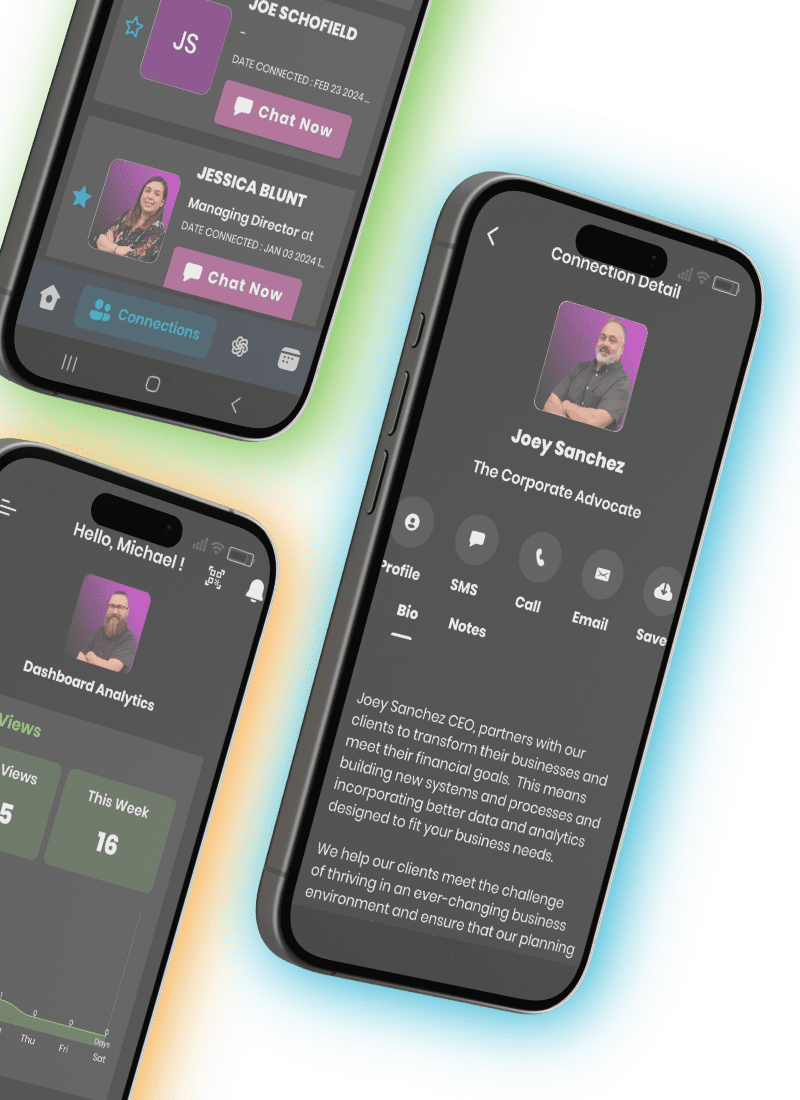Ever feel like you’re shouting into a crowded room when it comes to marketing your small business? You’re not alone. In today’s digital age, countless businesses vie for customer attention, making it a challenge to stand out from the pack. This is where brand differentiation comes in. It’s the secret sauce that transforms your brand from a generic face in the crowd into a magnetic force that attracts ideal customers. But for many small businesses, crafting a truly unique brand identity can feel like a guessing game.
Here’s where good news comes in. There’s a powerful tool at your disposal that you might be overlooking: your network. Think about it – your network is a treasure trove of connections, each with valuable insights and experiences. By leveraging data-driven brand differentiation, you can tap into this network to gather insights, uncover hidden audiences, and develop a brand story that truly resonates. Data analysis might sound intimidating, but fear not! We’ll break it down into manageable steps, showing you how to transform your network from a loose collection of contacts into a strategic asset that fuels brand differentiation.
The Importance of Brand Differentiation in a Crowded Marketplace
As someone who’s spent over a decade guiding small and micro businesses through the branding wilderness, I’ve witnessed firsthand the struggle of standing out in a crowded marketplace. Imagine a bustling street market overflowing with vendors selling similar wares. Each stall shouts for your attention, promising the best quality and the lowest prices. How do you decide where to spend your hard-earned cash? This exact scenario plays out online and offline every day, with countless businesses vying for customer attention.
Here’s where brand differentiation enters the game. It’s the magic ingredient that separates you from the generic crowd and positions you as the go-to solution for a specific customer need. Think of it like a neon sign that cuts through the marketplace noise, grabbing attention and drawing ideal customers towards your brand.
Now, brand differentiation isn’t just about having a catchy slogan or a cool logo. It’s about carving out a unique space in the customer’s mind, establishing yourself as the brand that truly understands their needs and offers a superior solution. The consequences of failing to differentiate are real. In a crowded marketplace, generic brands get lost in the shuffle. Customers struggle to differentiate you from your competitors, leading to price wars and a race to the bottom. Building a strong brand identity, however, empowers you to command premium prices, attract loyal customers, and foster long-term brand success. In the next section, we’ll delve deeper into the power of data and how it can fuel effective brand differentiation for your small business.
The Power of Data in Brand Differentiation
In the past, brand differentiation was often an exercise in intuition and guesswork. Businesses made decisions based on gut feelings and industry trends, hoping to resonate with their target audience. While this approach can work to a certain extent, it lacks the precision and direction that data-driven insights can provide.
Data empowers you to make informed decisions about your brand strategy, transforming brand differentiation from guesswork into a science. Think of it like having a map and a compass instead of wandering aimlessly through a dense forest. Data analysis allows you to pinpoint customer needs, identify market gaps, and tailor your brand message to resonate with a specific audience.
So, what kind of data are we talking about? The answer is – a multitude! Here are some key data sources that fuel brand differentiation:
- Customer Data: This includes information like customer demographics, purchase history, and feedback surveys. By analyzing customer data, you can gain a deeper understanding of your ideal customer’s needs, preferences, and pain points. This knowledge allows you to tailor your brand messaging and offerings to directly address their specific challenges.
- Market Research: Market research data provides valuable insights into industry trends, competitor analysis, and overall market sentiment. Knowing what your competitors are doing and how the market landscape is evolving empowers you to identify opportunities to differentiate your brand and carve out a unique space within your niche.
- Industry Trends: Staying on top of industry trends allows you to anticipate customer needs and adapt your brand accordingly. Data analysis of social media conversations, industry publications, and search trends can reveal emerging customer preferences and unmet needs. This allows you to position your brand at the forefront of innovation and attract customers seeking cutting-edge solutions.
By leveraging these different data sources, you can gain a comprehensive understanding of your target audience and the competitive landscape. This empowers you to craft a brand identity that truly resonates with your ideal customers, setting the stage for long-term success. In the next section, we’ll explore a powerful and often overlooked data source – your network.
Leveraging Your Network for Data Insights
Traditionally, data collection for brand differentiation has focused on external sources like market research firms and customer surveys. While these methods hold significant value, there’s a treasure trove of data waiting to be tapped much closer to home – your network.
Think about the vast web of connections you’ve built over time – industry colleagues, past clients, potential collaborators, even enthusiastic customers. Each individual within your network represents a unique perspective and a wealth of experience relevant to your niche. By strategically leveraging your network, you can unlock valuable data insights that can fuel powerful brand differentiation strategies.
Here’s how your network connections can contribute to your data analysis:
- Industry Expertise: Your network likely includes individuals who possess specialized knowledge and insights within your niche. These connections can offer valuable perspectives on customer needs, competitor strategies, and emerging trends. Informal conversations, interviews, or even collaborative content creation projects can provide a wealth of qualitative data that informs your brand differentiation efforts.
- Customer Feedback: Don’t underestimate the power of your existing customer base. Satisfied customers are not only a testament to your brand’s value proposition, but also a valuable source of data. By conducting surveys, hosting focus groups, or simply engaging in open communication with your customers, you can gather real-world feedback on their needs, challenges, and overall brand perception. This data allows you to identify areas for improvement and tailor your brand messaging to resonate more effectively.
- Market Validation: Your network can also be a valuable sounding board for testing brand differentiation ideas. Run new brand messaging concepts or product prototypes by colleagues or potential collaborators. Their insights can help you identify potential shortcomings or areas for refinement before you invest heavily in a specific brand direction.
The key to leveraging your network for data insights lies in building strong relationships. By fostering genuine connections and offering value to your network contacts, you create an environment of open communication and collaboration. This, in turn, allows you to tap into their knowledge and experiences, enriching your data analysis and fueling successful brand differentiation.
In the next section, we’ll delve deeper into how to identify specific data collection opportunities within your network.
Identifying Data Collection Opportunities Within Your Network
Your network is a vibrant ecosystem teeming with potential data points waiting to be harnessed. But how do you identify specific opportunities to gather valuable insights from your connections? Here are some creative strategies to get you started:
- Targeted Communication: Don’t approach your network with a one-size-fits-all data collection method. Consider the unique expertise and experience each connection offers. For industry colleagues, craft interview questions that delve into market trends and competitor analysis. For past clients, design surveys that explore their experience with your brand and identify areas for improvement. Tailoring your communication allows you to gather targeted data that directly informs your brand differentiation efforts.
- Content Collaboration Projects: Look for opportunities to collaborate with network connections on content creation projects like blog posts, white papers, or even co-hosted webinars. These collaborations not only provide valuable content for your audience but also open doors for data exchange. During the brainstorming and development process, discussions naturally flow towards industry challenges, customer needs, and emerging trends. This collaborative environment fosters the sharing of valuable insights that contribute to your data analysis.
- Social Listening: Social media platforms can be a goldmine of customer sentiment and industry trends. Leverage social listening tools to track online conversations relevant to your niche and your brand. By following industry hashtags, monitoring competitor mentions, and analyzing customer reviews, you can glean valuable insights into brand perception and identify areas where your brand can differentiate itself. Remember, social media listening is not just about monitoring brand mentions, but also about understanding the broader industry conversation and the needs your target audience expresses online.
- Open Communication Channels: The most effective way to leverage your network for data collection is to foster open communication channels with your connections. Schedule regular calls with key industry contacts, host online forums for customer feedback, and actively participate in relevant online communities. By creating an environment where information exchange is encouraged, you’ll be surprised at the wealth of data and insights that emerge organically through ongoing conversations.
When collecting data from your network, remember the importance of reciprocity. Don’t just take; give back as well. Offer your expertise, promote your network connections’ work, and celebrate their successes. Building strong, mutually beneficial relationships within your network ensures a continuous flow of valuable data and empowers you to leverage your network’s collective intelligence for long-term brand differentiation success.
Meet the Enriched Contact Platform
Get Your Free SyncVIP Profile Now!
Sign up for your free VIP profile now and start making connections that matter.
In the next section, we’ll explore how to analyze network-derived data to uncover hidden customer pain points – a crucial step for crafting a truly differentiated brand.
Analyzing Network Data to Uncover Customer Pain Points
You’ve tapped into your network, gathered a wealth of data, and now it’s time to transform that raw information into actionable insights. Here’s where data analysis comes in, specifically focusing on uncovering customer pain points – the struggles, frustrations, and unmet needs that plague your target audience. By analyzing network-derived data through this lens, you can identify opportunities to differentiate your brand by addressing these pain points in a way your competitors haven’t.
Here’s how to approach data analysis for uncovering customer pain points:
- Thematic Analysis: Qualitative data from interviews, focus groups, or open-ended survey responses often reveals recurring themes. Employ thematic analysis techniques to identify these common threads. For example, analyzing customer feedback might reveal a consistent theme of frustration with product complexity or lack of customer support. These recurring themes represent significant customer pain points that your brand can address through targeted differentiation strategies.
- Sentiment Analysis: Many data analysis tools allow you to perform sentiment analysis, gauging the emotional tone of customer feedback and online conversations. By identifying negative sentiment surrounding specific topics or competitor products, you can pinpoint areas where customers are experiencing pain points. This allows you to develop brand messaging and product offerings that directly address these frustrations, positioning your brand as the solution that alleviates their pain and delivers superior value.
- Comparative Analysis: Network data often reveals valuable comparisons between your brand and your competitors. Analyze customer reviews, industry reports, and social media conversations to understand how your brand is perceived relative to your competitors. Identifying areas where competitors fall short or fail to address customer needs effectively presents a golden opportunity for differentiation. By focusing on these unmet needs, you can craft a brand message that highlights your unique ability to solve customer pain points, setting you apart from the competition.
Remember, customer pain points are a goldmine for brand differentiation. By leveraging network data and employing effective data analysis techniques, you can uncover these hidden opportunities and tailor your brand strategy to address them. In the next section, we’ll explore how network data can help you discover entirely new audience segments with unique pain points – a powerful strategy for niche domination.
Leveraging Network Insights to Discover Hidden Audiences
Traditionally, brand differentiation has focused on targeting established customer segments within a niche. But what if there’s a way to expand your reach and discover entirely new audiences with specific needs and preferences? Believe it or not, your network holds the key. By analyzing network insights, you can uncover hidden audience segments – niche pockets of potential customers your competitors might be overlooking.
Here’s how network data empowers you to discover these hidden audiences:
- Industry Expertise: Leverage the knowledge of industry colleagues and thought leaders within your network. Through interviews, discussions, or collaborative projects, gain insights into emerging trends and unmet needs within your broader niche. For example, an industry expert might mention a growing sub-segment within your target market facing unique challenges not addressed by existing brands. This hidden audience represents an opportunity for brand differentiation by tailoring your messaging and offerings to their specific needs.
- Customer Feedback Analysis: Customer feedback, both positive and negative, can reveal hidden audience segments. Analyze reviews that mention alternative use cases for your product or service. These might indicate a fringe customer segment with unique needs that your brand could potentially cater to. For instance, a customer using your product for an unintended but successful purpose could represent a hidden audience within a completely different industry.
- Social Listening Beyond Your Niche: Don’t limit your social listening to your immediate niche. Use social media monitoring tools to explore conversations on the periphery of your industry. Look for discussions where your product or service could potentially offer a solution, even if it wasn’t originally intended for that audience. These conversations might reveal hidden audience segments with overlapping needs that your brand, with some strategic adjustments, could effectively address.
- Network Connections as Gateways: Your network connections can act as gateways to hidden audiences. Industry colleagues might work with complementary businesses that cater to niche segments you haven’t considered. Explore opportunities to collaborate with these businesses or tap into their customer base with targeted marketing campaigns. By leveraging your network connections, you gain access to entirely new audience segments with unique pain points, presenting a strategic advantage for brand differentiation.
The beauty of discovering hidden audiences lies in the potential for niche domination. By addressing their specific needs and tailoring your brand message accordingly, you can establish yourself as the go-to solution within this new audience segment. This not only expands your customer base but also positions your brand as a leader in innovation and audience understanding, further solidifying your brand differentiation efforts.
In the next section, we’ll explore how to translate network-derived data into a compelling brand story that resonates with your target audience, propelling your brand differentiation to new heights.
Using Network Data to Craft a Data-Driven Brand Story
Numbers and statistics are powerful, but they can also feel cold and impersonal. When it comes to brand differentiation, data analysis is crucial, but it’s only half the equation. The true power lies in translating that data into a compelling brand story that resonates with your target audience.
Here’s how to leverage network-derived data to craft a data-driven brand story that differentiates you from the competition:
- Identify Your Audience Segment: Network data not only uncovers customer pain points, but also helps you define your ideal customer segment more precisely. By analyzing feedback and industry insights, you gain a deeper understanding of their demographics, challenges, and aspirations. This allows you to tailor your brand story to speak directly to their needs and resonate on a deeper emotional level.
- Highlighting Shared Struggles: Network data reveals common pain points within your target audience segment. Use your brand story to acknowledge these shared struggles and frustrations. This creates a sense of connection and empathy, demonstrating that you understand their challenges on a personal level.
- Positioning Your Brand as the Solution: Once you’ve established a connection through shared struggles, use your brand story to position yourself as the solution. Leverage network insights to showcase how your product or service addresses their specific pain points in a way your competitors don’t. Provide concrete examples and data-driven evidence to support your claims, building trust and credibility with your audience.
- Emphasize Uniqueness: Network data empowers you to identify what sets you apart from the competition. Whether it’s a unique product feature, a superior customer service approach, or a commitment to social responsibility, weave your brand’s unique selling proposition (USP) into your brand story. Highlighting what makes you different grabs attention and positions you as the standout choice within your niche.
- Weaving in Personal Experiences: Network data can be incredibly insightful, but don’t forget the power of storytelling. Supplement your data-driven narrative with personal anecdotes from customer experiences, success stories, or even challenges you’ve overcome as a brand. This humanizes your brand story, fostering emotional connection and building trust with your audience.
By following these steps, you can transform network-derived data into a compelling brand story that resonates with your target audience. This data-driven narrative not only differentiates your brand but also creates an emotional connection that drives customer engagement and brand loyalty.
From Niche Nobody to Differentiated Leader: The Power of Network-Driven Brand Strategy
In today’s fiercely competitive marketplace, standing out from the crowd is no easy feat. Small businesses often struggle to differentiate themselves, getting lost in a sea of similar offerings. But what if the secret weapon for brand differentiation wasn’t a hefty marketing budget, but the connections you’ve already built?
This guide has unveiled the power of leveraging your network for data-driven brand strategy. By tapping into the expertise, experiences, and perspectives within your network, you can unlock a treasure trove of insights that inform powerful differentiation strategies.
Network data analysis empowers you to uncover hidden customer pain points, discover niche audience segments, and craft a compelling brand story that resonates with your ideal customers. This data-driven approach allows you to differentiate your brand from the competition, establish yourself as a thought leader, and attract loyal customers who value your unique solutions.
Remember, brand differentiation is a continuous journey. As your business evolves, so too should your network analysis. Regularly revisit your network connections, gather fresh data, and adapt your brand strategy accordingly.
Here at SyncVIP, we understand the challenges and opportunities that come with building a strong brand identity. That’s why we created a platform specifically designed to streamline network collaboration and data analysis for small businesses. SyncVIP empowers you to:
- Centralize Network Connections: Build a central hub for all your network contacts, facilitating easy communication and collaboration.
- Simplify Data Collection: Utilize user-friendly tools to gather data from your network through surveys, polls, and communication channels.
- Streamline Data Analysis: Gain valuable insights from your network data with intuitive reporting and visualization tools.
- Fuel Brand Differentiation: Leverage data-driven insights to craft a unique brand story that sets you apart from the competition.
Ready to unlock the power of your network and propel your brand towards differentiation and success? Sign up for your free SyncVIP account today and see the difference it can make!















